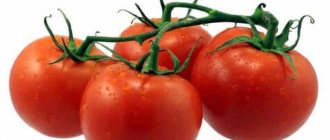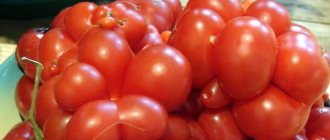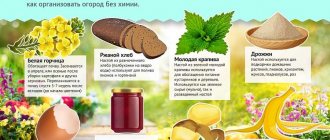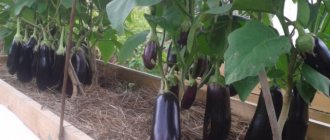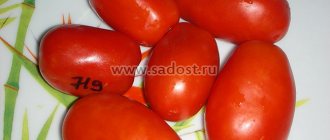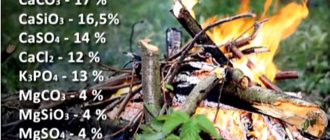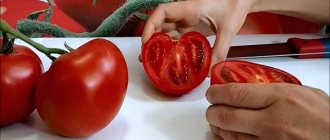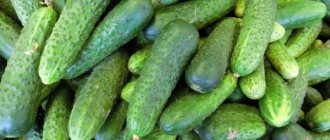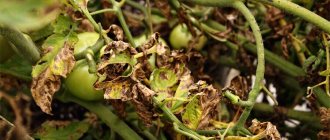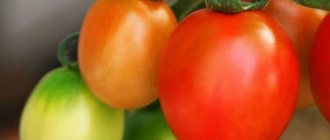Potassium is an important chemical element necessary for a comprehensive balanced nutrition of all vegetables. It ensures full growth and development of the plant. On tomatoes suffering from a lack of potassium during ripening, you can often see half-green fruits that will never ripen. In order not to spoil the harvest, you need to carefully monitor the condition of the plants and at the first signs of potassium deficiency, fertilize them.
Potassium value for tomatoes
Why do you need potassium for tomatoes? The element is required for the following processes:
- rooting seedlings in a permanent place;
- facilitating adaptation to temperature changes and open ground conditions;
- strengthening immunity and disease resistance;
- improvement of metabolism;
- formation of ovaries, proper ripening of fruits.
In addition, it is common to treat blossom end rot on tomatoes with potassium fertilizers. Top rot appears from a lack of certain microelements; spraying is carried out to replenish it.
Signs of shortage
The lack of important nutrients can be seen with the naked eye.
Main features:
- plant growth slows down;
- the color of the leaves changes from green to dark green, blue, and a purple tint appears;
- if the situation is neglected, the foliage curls and falls;
- shoots become small;
- red blotches and brown spots on the foliage form on the cuttings;
- tomatoes drop their inflorescences;
- There is a delay in flowering, the fruits ripen slowly.
Types of products for greenhouses and vegetable gardens
Tools by names and descriptions will help a beginner choose the most suitable ones. The best fertilizer for tomatoes is selected taking into account the properties of the soil. Potassium for plants in a greenhouse is needed in smaller quantities than in open ground. A safe way to feed tomatoes with potassium during the development of the bush and during the fruiting period is to use folk remedies. They are not as concentrated as mineral supplements and do not cause burns in case of overdose.
Foliar feeding of tomatoes with potassium is carried out by spraying; this is a quick and effective method to quickly compensate for the beginning deficiency. A number of home and industrial remedies are suitable for it, in particular, multipotassium. When looking for how to feed the bushes with potassium during the fruiting period, it is better to give preference to harmless homemade solutions.
The use of potash fertilizers in different periods of growth
To prevent plants from suffering from potassium deficiency, we carry out regular fertilizing according to the following scheme:
- We apply the main fertilizer in the spring before planting seedlings (pre-sowing stage). It ensures that the soil is saturated with the necessary nutrients. We also carry out this fertilizing in the fall, so that during the winter the soil absorbs all the mineral elements.
- We apply fertilizers when planting plants in the ground (pre-sowing stage). Such feeding will help the seedlings to “survive” the transplant more easily, adapt to the temperature regime and develop the root system. Thanks to this, the plant will develop steadily.
- Post-sowing stage. Acts as an auxiliary to the previous two. Top dressing nourishes the plant during the period of its intensive development and provides necessary substances during fruit ripening.
Organic products
Ash
It also contains a lot of calcium. The product is suitable for any type of soil, has no side effects and is a source of many other microelements - phosphorus, boron, magnesium, iron. It is especially good to use on peat lands. If it was not possible to prepare a lot of ash, it is combined with other fertilizers.
The ash obtained from burning pine and birch firewood is the most useful, it contains up to 12% potassium.
Manure
It is a source of nitrogen and phosphorus. For 1 sq. m requires 6 kg of rotted manure, it is incorporated into the soil every six months.
Microelements from fresh mullein are not absorbed by plants. It must be allowed to rot for at least 7 months under a twenty-centimeter layer of peat.
Banana peel
It contains enough phosphorus, magnesium and calcium. Peels and whole spoiled bananas need to be chopped, filled with water and left to steep. The water is then used for irrigation and spraying.
Selection rules
If the soil is depleted, it is better to apply fertilizers in the fall, during digging. Insoluble or slightly soluble fertilizers that have a long-lasting effect are suitable for this.
During the growing season of tomatoes, soluble bait is suitable, which is used in dry and liquid form.
When choosing fertilizer, take into account the characteristics of the soil. If the soil is acidic, then using complex fertilizers is not recommended because they contain chlorine. It is better to choose products with potassium sulfate.
Soil characteristics are taken into account when choosing fertilizer
Mineral
Potash
It is known as potash. Contains sulfur, magnesium and up to 55% potassium. Particularly useful for reducing acidity and improving the quality of acidic soils. For each square meter, take 20 g of fertilizer; in spring and autumn, increase the dose at least twice.
Calimagnesia
From the name it is clear that the second substance in it is magnesium. Apply up to 10 g per 1 square meter under the root. m. If the soil is sandy, more treatments are needed; in ordinary soils, three are carried out: when transplanting seedlings into the garden, during flowering and immediately before the formation of ovaries.
The fertilizer does not contain chlorine.
Potassium monophosphate
It also contains phosphorus. Suitable for watering and spraying, it poses almost no danger in case of overdose, as it quickly decomposes in the ground. Does not acidify the soil. Take 10 g of powder per bucket of water.
The drug is useless if it is allowed to become damp or the solution is exposed to direct sunlight.
Potassium nitrate
This is potassium nitrate. Contains nitrogen. For watering, take 20 g of granules or powder per bucket of water, for spraying - 25 g. You can scatter the powder on the ground in the spring.
You cannot use saltpeter later than 4 days before harvesting tomatoes.
If the dosage is not observed, nitrates are deposited in the fruits, which are dangerous to human health.
Nitroammofoska
It is also a source of phosphorus and nitrogen. Protects plants from root and stem rot, late blight, scab, and is suitable for both acidic and alkaline soils. When digging, add 40 g per square meter.
Potassium sulfate
Optimal for acidic soils, black soils, peat bogs, sandy soil. For 1 sq. m requires approximately 20 g of the drug. However, the product forms dangerous substances in fruits if the dosage is exceeded. It is necessary to work with it wearing protective glasses and gloves.
Gardener mistakes
- When choosing potassium fertilizers, many novice gardeners make a serious mistake - they forget that tomatoes are a vegetable crop that does not tolerate the effects of chlorine very well. Many fertilizers containing potassium also contain chlorine, for example, potassium chloride and potassium salt. These fertilizers cannot be used for feeding tomatoes. However, in order to enrich the soil with potassium, we add potassium chloride to the soil for the winter. During this time, the components of the choir will evaporate, and in the spring we will get soil saturated with potassium.
- Much does not mean good. Excess potassium can harm plants just as much as too little potassium. Therefore, use fertilizers according to instructions and dosage.
- Do not apply all types of fertilizers at once; plants need time to absorb and “digest” the components. To ensure that tomatoes absorb potassium elements well, do not apply nitrogen group fertilizers, including manure, before fertilizing with potassium.
Potassium plays an important role in plant life. It helps them develop properly, makes them stronger and more resilient, increases the volume and quality of the harvest. By using potash fertilizers in a timely manner and correctly, you can please yourself and your loved ones with delicious and ripe tomatoes.
Other fertilizers
Along with conventional fertilizers, gardeners use natural fertilizers and boric acid in the greenhouse. Spraying tomato bushes with a solution of boric acid is useful for flowering and fruiting; boron improves the absorption of nutrients and prevents rotting. The seeds are also allowed to brew in the preparation. You need to dilute 200 g of boric acid in a liter of water and put the seeds there for a day, then they will sprout faster.
For prevention, you can spray tomatoes with iodine. It destroys pathogenic bacteria and drives away harmful insects. If the seedlings do not grow well, we use yeast. For 10 liters of water you need 10 g of yeast powder. The yeast must be diluted and allowed to brew, and then water the bushes with the resulting fertilizer.
The green mass of tomatoes is sprayed with diluted milk to protect the plantings from pests. Natural milk is poured under the roots to saturate the crop with nutrients.
In addition to natural feeding, the drug Kornevin has a good effect on growth. With its help, seeds and seedlings become stronger and do not die. The drug is used to treat seeds, pollinate seedlings and saturate the roots with important elements.
Micronutrient deficiency
Potassium deficiency in tomatoes can be diagnosed based on changes in leaves and fruits. The main symptoms of a deficiency of this microelement are:
- The appearance of a dry edge on the leaves. Its color is initially light, but over time it acquires a brown tint. It is worth noting that drying begins from the tip of the leaf blade and gradually spreads along the entire perimeter of the leaf.
- Tomato ovaries are formed in insufficient quantities.
- Vegetables ripen unevenly.
- On the fruits you can see unripe spots at the stalk.
Important! Potassium deficiency can be caused by excessive addition of calcium to the soil. Potassium and calcium are antagonists.
Based on these characteristic signs, a caring owner should detect the problem as early as possible and take all necessary measures to eliminate it, namely, spray or water the plant roots with potassium fertilizers.
